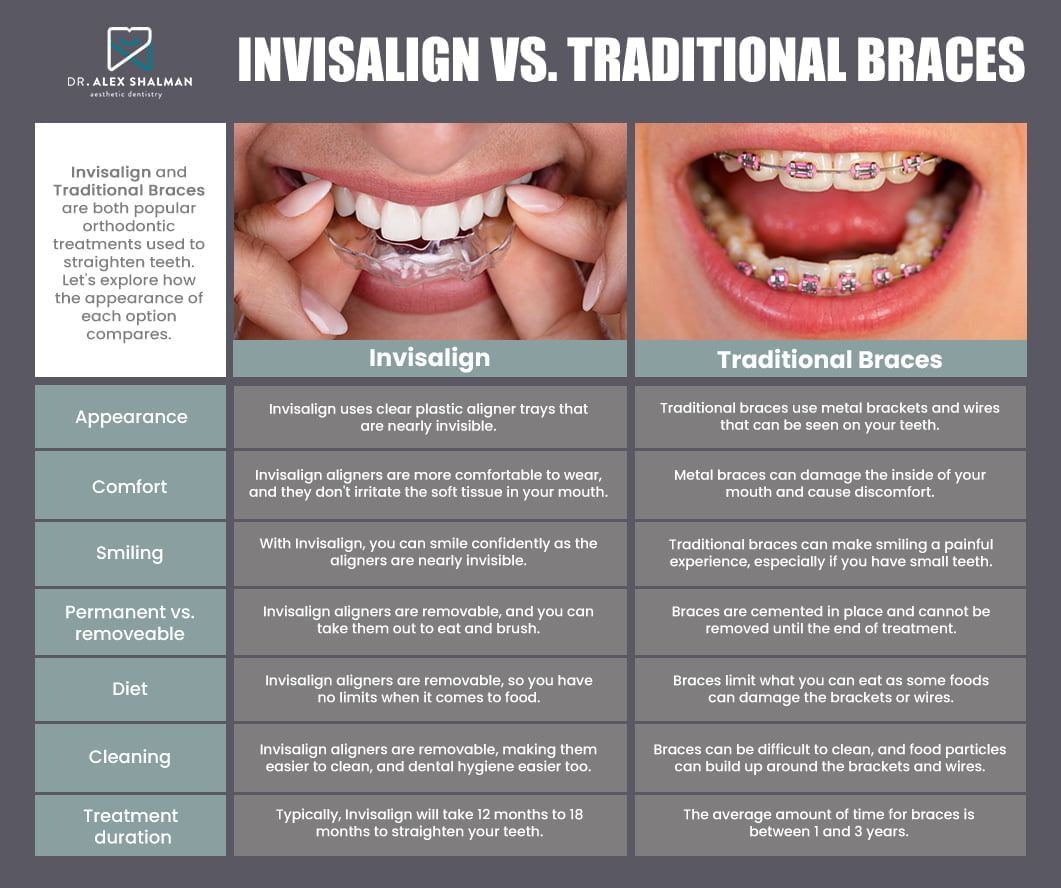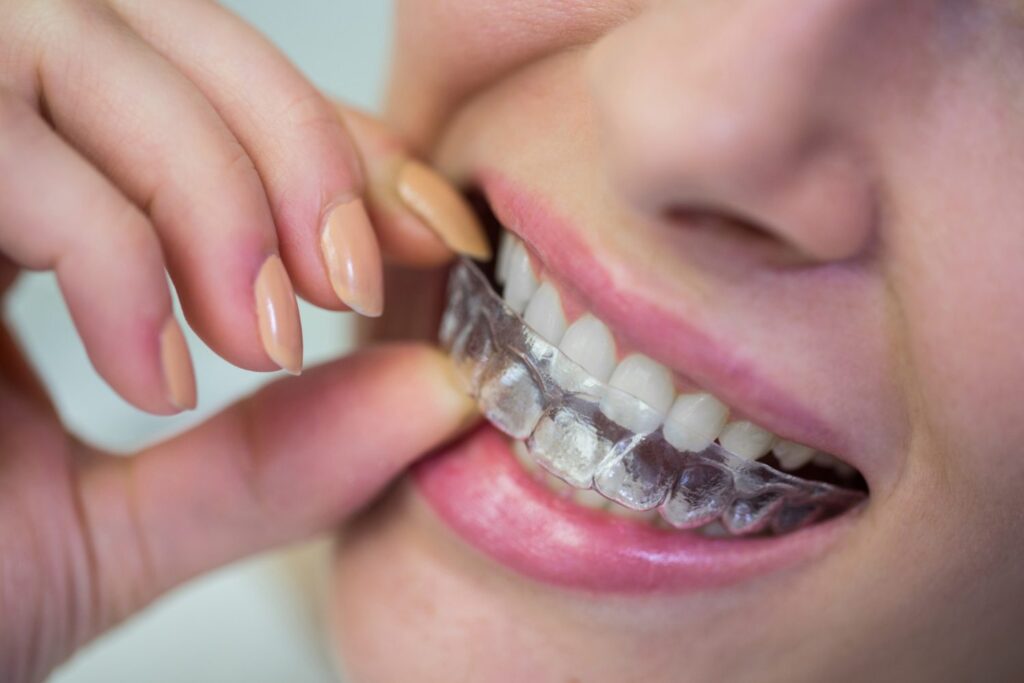Invisalign vs. Conventional Dental braces: Which Alternative Is Right for You?
When thinking about orthodontic treatment, the choice between Invisalign and typical dental braces provides a number of essential factors that merit mindful evaluation. Invisalign supplies a very discreet alternative with removable aligners, while typical dental braces offer a more noticeable yet reliable option for severe imbalance.
Introduction of Treatment Options

In contrast, traditional dental braces include steel braces and cords that are adhered to the teeth. This method applies continual pressure gradually to accomplish placement. While reliable for complicated orthodontic problems, standard braces call for normal gos to for changes and can pose difficulties in preserving dental health due to the problem of cleansing about brackets and cords.
Both choices have their benefits, and the selection typically depends upon particular oral conditions, way of living preferences, and client conformity. Eventually, seeking advice from an orthodontic expert is crucial for identifying one of the most ideal treatment strategy customized to individual needs. Understanding the nuances of each option can dramatically affect the overall success of orthodontic treatment.
Aesthetic Factors To Consider
A substantial aspect influencing the option between Invisalign and conventional braces is the aesthetic appeal each treatment supplies. Invisalign aligners are crafted from clear plastic, making them basically unnoticeable when worn.
On the other hand, traditional braces contain steel braces and wires, which can be more noticeable. While advancements in orthodontic technology have actually brought about the growth of smaller sized braces and tinted elastics, conventional dental braces still preserve an even more noticeable account. For some individuals, the presence of braces might discourage them from looking for required therapy.
Eventually, the selection between Invisalign and traditional dental braces might pivot on personal choices concerning appearances. Individuals that focus on discretion usually lean towards Invisalign, while those that are much less concerned concerning presence might select conventional dental braces. Recognizing the visual implications of each option is crucial for making an educated decision that aligns with one's way of life and preferences.
Comfort and Convenience

In regards to convenience, Invisalign aligners are removable, making it possible for patients to appreciate their favorite foods without constraint and preserve optimum dental hygiene. Cleaning and flossing are streamlined, as the aligners can be gotten during these routines, whereas conventional dental braces need cautious navigating around wires and brackets.
In comparison, conventional dental braces necessitate routine adjustments, making them less hassle-free for those with hectic timetables. In general, the convenience and convenience of Invisalign make it an attractive selection for numerous people seeking orthodontic therapy.
Treatment Period and Effectiveness
While both Invisalign and typical braces are effective in remedying dental imbalances, the duration of therapy can differ significantly in between both alternatives. Typically, Invisalign therapy can take anywhere from 12 to 18 months, depending upon the intricacy of the case. The clear aligners function by gradually changing teeth into their desired settings, and normal follow-ups with an orthodontist click here now help guarantee progression remains on course.
On the other hand, standard dental braces commonly need a longer dedication, usually varying from 18 months to 3 years. This results from their fixed nature and making use of wires and brackets, which can be much more efficient for complicated situations and severe misalignments (Invisalign). The treatment effectiveness of conventional braces is well-documented, as they enable accurate modifications and higher control over tooth motion
Eventually, the option between Invisalign and conventional braces may pivot on both the awaited therapy period and the certain dental issues at hand. Consulting with an orthodontist is essential, as they can offer tailored suggestions based on individual needs, ensuring the chosen method aligns with desired outcomes and durations.
Cost Contrast and Insurance Policy Choices
Cost plays a significant duty in the decision-making process for individuals taking into consideration orthodontic therapy, whether going with Invisalign or traditional dental braces. Generally, the cost of Invisalign arrays from $3,000 to $8,000, while standard braces commonly set you back between $2,000 and $6,000. Variables influencing these costs consist of the complexity of the instance, the period of treatment, and geographical area.
Insurance policy protection can significantly influence out-of-pocket costs. Many oral insurance strategies offer partial insurance coverage for orthodontic treatments, but the specifics can vary widely. It is important for clients to review their visit insurance plan to establish the degree of coverage for either option. Generally, traditional braces might be extra regularly covered by insurance plans contrasted to Invisalign, which some insurers classify as a cosmetic procedure.
Additionally, a number of orthodontic techniques supply adaptable layaway plan, making both treatment choices extra accessible. Clients must ask about potential financing choices and price cuts for upfront repayments. Examining the complete cost, including insurance coverage advantages and payment plans, is crucial for making a notified choice that straightens with both aesthetic choices and spending plan considerations.

Final Thought
In recap, the choice in between Invisalign and standard dental braces hinges on numerous factors, including aesthetic choices, comfort, treatment duration, and price. Invisalign offers a very discreet, removable choice that helps with dental hygiene and dietary versatility, while conventional dental braces might be preferable for intricate oral concerns and commonly come with a lower price factor. Eventually, examination with an orthodontist is necessary to evaluate individual conditions and establish the most appropriate therapy choice for achieving optimum dental alignment.
When considering orthodontic therapy, the option in between Invisalign and standard braces presents numerous essential elements that warrant cautious assessment.Comparing Invisalign and traditional dental braces exposes distinct therapy alternatives for orthodontic improvement.While both Invisalign and typical dental braces are effective in correcting oral misalignments, the duration of treatment can vary significantly between the two options.Cost plays a significant duty More Bonuses in the decision-making procedure for people taking into consideration orthodontic therapy, whether opting for Invisalign or typical braces.In recap, the choice in between Invisalign and typical dental braces pivots on numerous aspects, consisting of visual preferences, comfort, treatment duration, and price.